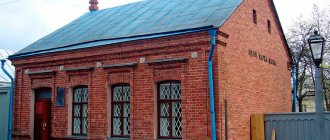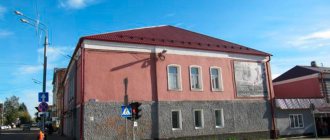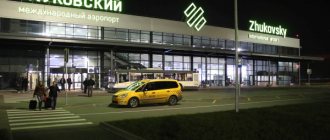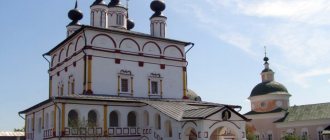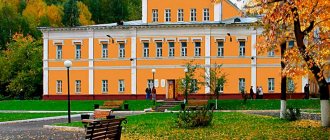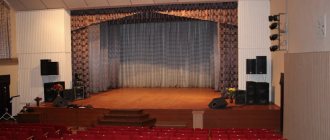Maloyaroslavets is a small town in the Kaluga region, which became the scene of bloody battles of two Patriotic Wars: 1812 and 1941-1945. It bears the title “City of Military Glory”.
The settlement was founded by Prince Vladimir Serpukhovsky, who earned the nickname Brave for his military exploits. The city was named after Yaroslav, the prince’s newborn son.
Maloyaroslavets is permeated with the memory of historical battles:
- In 1812, the Battle of Maloyaroslavets became a turning point in the war with Napoleon. The French were not allowed into the rich southern regions of the country and were forced to return along the devastated Smolensk road;
- in 1941, the attack on Moscow was delayed at the Ilyinsky lines.
The Ugra River, caves and waterfalls, museums and estates - what not to miss when traveling around the Kaluga region?
Briefly about Maloyaroslavets
Maloyaroslavets is located in the Kaluga region in the south-west direction from Moscow. The distance from the capital is 110 km, and from Kaluga – 60 km. The area of the city is 18 km2, the number of inhabitants is about 30 thousand people. The climate is similar to Moscow. This is a small, but very neat city. In 2005, it became one of the winners in the competition for the most comfortable city in Russia with a population of less than 100 thousand people.
City `s history
On the banks of the Luzha River, the largest river in Maloyaroslavets, objects dating back to the beginning of the last millennium were discovered in excavations. The first written mention of the city dates back to 1402 and is considered the date of its birth. Since 1776, Maloyaroslavets has been the center of the county.
The year 1402 indicated on the stele is the date of birth of Maloyaroslavets
Maloyaroslavets gained all-Russian fame after the battle between Russian troops and French troops during the retreat of Napoleon’s army from Moscow in 1812. Field Marshal M.I. Kutuzov, with successful tactical maneuvers, disrupted the plans of the demoralized French army to move to food-rich Kaluga. Russian troops dealt a crushing blow to the invaders and sent them along the devastated Smolensk road. This battle served as a turning point in the Patriotic War of 1812 and led to the victory of the Russian troops. However, the city itself was severely destroyed and had to be rebuilt: temples, houses, and a monastery were restored.
During the Great Patriotic War, Maloyaroslavets became famous for the victory of the Red Army troops over the Nazis in the Battle of Moscow . In 1941, the city was occupied for several months, and members of the local underground and partisans fought the Germans. Thanks to the correct decisions of the command of our armed forces, after a series of fierce battles in early 1942, Maloyaroslavets was liberated and served as a protective line on the enemy’s path to the capital.
Video: chronicle of the liberation of Maloyaroslavets in 1942
After 1945, the city, which became the center of the Maloyaroslavets district of the Kaluga region, was revived again. In 2012, it was awarded the title “City of Military Glory.”
How to get to Maloyaroslavets
Maloyaroslavets is a large transport hub connected by direct long-distance trains to Moscow and Russian cities on the Moscow-Bryansk route, as well as by electric trains. Along federal highways you can get to Maloyaroslavets by regular buses and private car. Travel time from the capital is about two hours, from Kaluga - 50 minutes.
Churches and temples
Nikolsky Chernoostrovsky Monastery
Address: st. Kutuzova, 23 Phone: 8 48431 2-14-69 Website: stnikolamon.ru Opening hours: Mon-Sun 8:00 20:00
The mountain on which the monastery stands was called Special or Black Ostrog. Therefore, the monastery began to be called Chernoostrogsky. Over time, the name was transformed into Chernoostrovsky.
Initially, in the 14th century, back in the specific time, the Obolensky princes built the Church of St. Nicholas here, and the monastery was formed after the annexation of the local lands to the Moscow Principality.
Until the 18th century, the monastery eked out a miserable existence and was even abolished due to lack of funds for maintenance, until the merchant Terenty Elizarovich Tselibeev undertook the restoration of the monastery in 1791, who invested huge amounts of money into it.
The monastery suffered heavy losses during the battle with Napoleonic army. All its buildings were burned, only the main gate remained. The enemy shells miraculously did not touch the face of Christ, riddling the entire surface around. Traces of French bullets have survived to this day.
Since 2009, there has been a new icon above the gate - “Savior Not Made by Hands”.
The monastery has not preserved any ancient church decoration. Everything was destroyed and looted after the October Revolution.
Nowadays there are three churches on the territory of the monastery: St. Nicholas, All Saints and the Korsun Icon of the Mother of God. In the temples of the monastery you can venerate the Orthodox shrines:
- a crucifix with a piece of the Life-Giving Cross and the Robe of the Lord;
- icons with the relics of the Kiev-Pechersk saints, Optina elders, Sergius of Radonezh.
The road to the St. Nicholas Church through the territory of the monastery passes directly under the snow-white high bell tower, where there is a wooden sculpture of St. Nicholas the Pleasant with a burning lamp in front of it. To the right of the bell tower is a holy spring with spring water and a font.
The monastery is for women, very cozy and well-groomed. Everything is done by the hands of the novices. There are many flower beds on the territory. On the lower platform of the open-air monastery there is a mosaic made of colored stones.
The monastery has opened the Otrada shelter for girls from disadvantaged families.
Cathedral of the Kazan Icon of the Mother of God
Address: pl. Lenina, 1 Phone: 8 48431 2-33-88 Opening hours: Mon-Sun 09:00-17:00
Initially, on the site of the cathedral there was a wooden church of St. George the Victorious.
The stone temple was built in 1742-44 at the expense of retired brigadier Afanasy Prokofievich Radishchev, the grandfather of the author of “Travel from St. Petersburg to Moscow.” He was buried in the same temple.
The cathedral's shrine was an ancient image of Tsarevich Dimitri, painted in 1685 by Ivan Ivanovich Burenin from Uglich.
During the Napoleonic War, the cathedral suffered particularly badly, as it was at the epicenter of the battle.
Under Soviet rule, the temple was completely destroyed. Returned to the church in the 2000s.
Now the temple has been restored. It is notable for the bright blue color of its domes. It operates a spiritual and educational center with a school and a cadet corps.
Cathedral of the Assumption of the Blessed Virgin Mary
Address: pl. Lenina, 12 Phone: 8 48431 3-00-93 Opening hours: Mon-Sun 09:00-17:00
Built as a temple-monument to the centenary of the victory over Napoleon. Funds for construction were collected throughout Russia. With the consecration of the temple in October 1912, celebrations began on the occasion of the centennial date of the Battle of Maloyaroslavets.
The restoration of the cathedral after its destruction by Soviet power was carried out by Archpriest Vasily Mashkov. He carried out a complete reconstruction of the temple. There is a Sunday school at the cathedral.
Church of the Nativity of John the Baptist
Address: st. Kutuzova, 2 Phone: 8 48431 2-14-69 Opening hours: Mon-Sun 09:00-19:00
The temple was built in the Old Russian style in 1772 by a Moscow merchant, a native of Maloyaroslavets, Terenty Tselibeev, on the site of an old wooden church that had stood here since the end of the 15th century.
Since 1930 the temple has been closed. For a long time it was used for other purposes, it was destroyed, and in 2000 the ruins were returned to the parishioners.
Now services are held in the restored temple.
Sights of Maloyaroslavets
All the sights of the city can be explored on your own in one day, since most of them are located near the historical center of the city - Sennaya Square.
Using the map you can build a walking excursion route around the city
Military victories and mass graves
Since Maloyaroslavets is famous for battles that significantly influenced the course of the War with Napoleon of 1812 and the outcome of the Battle of Moscow in the Great Patriotic War, there are many places in the city associated with these events.
Sennaya Square of Maloyaroslavets
This is the historical and administrative center of the city. In 1844, by decree of Nicholas I, a monument was erected here in honor of the victory of the Russian army over Napoleon's army (created by the Italian sculptor Antonio Adamini). However, in 1932 the monument was destroyed, and at the end of the last century, townspeople began to restore the stele using private savings. It was erected on the previous foundation, in which ancient medals were discovered, given to the Maloyaroslavets Military History Museum in 1812.
In 2002, a monument to Prince Vladimir Andreevich of Serpukhov and Borovsk was erected on the main square of Maloyaroslavets. The author of the sculpture is A. Artimovich. The prince, who received the nickname Brave (Donskoy) after participating in the victorious Battle of Kulikovo, is revered for his courage and heroism. He laid the foundation for the creation of the future city and gave it a name.
Photo gallery: Sennaya Square of Maloyaroslavets
Sennaya Square of Maloyaroslavets is the spiritual “heart” of the city
The monument to the memory of the events of 1812 was restored on the initiative and at the expense of the population
Residents of Maloyaroslavets honor Prince Vladimir Andreevich Brave (Donskoy) - the founding father of the city
Information for travelers: from the railway station and bus station of Maloyaroslavets you can walk to Sennaya Square in 20 minutes or take bus No. 101 and minibuses No. 1,2,3,4 in 7 minutes (stop “Herzen Street, 32”).
Museum-chapel in the Square of 1812 and diorama of the battle
The museum-chapel is located near Sennaya Square in Maloyaroslavets. The chapel was built in 1860 in the 1812 Square at the expense of a participant in the historical battle. In pre-revolutionary Russia, memorial services in memory of the dead and religious processions were held here. In 1948, the Maloyaroslavets Military History Museum of 1812 was placed in the chapel.
On September 12, 1987, the diorama “The Battle of Maloyaroslavets on October 12/24, 1812” was opened, which became one of the three branches of the museum. The voluminous diorama canvas, created by the artist E. I. Deshalyt, gives a detailed picture of what is happening and, with the help of light, music and sounds, creates a feeling of presence on the battlefield.
A diorama is a pictorial picture, curved in a semicircle in the shape of a ribbon, with a foreground in the form of structures, real and fake objects.
Information for travelers:
- address - st. Moskovskaya, 13;
- ticket price: 80 rubles for adults, 30 rubles for students and pensioners, children under 16 years old are admitted free.
Photo gallery: museum-chapel in Maloyaroslavets
The diorama “The Battle of Maloyaroslavets on October 12/24, 1812” is on display in the museum-chapel.
A colorful and realistic diorama canvas creates the effect of participating in a battle
The museum-chapel is located next to the Sennaya Square of Maloyaroslavets
Monument to the regimental priest
In 2014, the only monument to a regimental priest in the country was erected near the church fence. The prototype for the sculptor Salavat Shcherbakov was the priest Vasily Vasilkovsky, who took part in the legendary battle with the French near Maloyaroslavets and was awarded the Order of St. George, 4th degree, for courage and heroism. In Russian history, this is the first church minister to receive such an award.
The sculpture of a priest at the temple gates is a symbol of the dedication of peaceful Russians who stood up unarmed to defend the Fatherland
Mass graves of heroes of 1812
The mass graves of the heroes of 1812 are a cultural and historical city site. Thousands of people died during the battle of Maloyaroslavets. Many soldiers were buried in common graves on the territory of the city, two of them are located in the 1812 Square, one in the Bessonovsky cemetery. The burials were marked with high earthen mounds and wooden crosses. For the centennial anniversary of the battle, it was decided to create sculptural compositions on the graves. Every year on October 12, hundreds of townspeople, after a solemn service in the chapel, go to the mass graves to pay tribute to the heroes and lay wreaths at the foot of the monuments.
Photo gallery: mass graves of heroes of 1812
In front of the grave of heroes in Square 1812, a bust of Kutuzov, the organizer and inspirer of the defeat of the French, was installed
The figure of the warrior is dressed in the uniform of the light infantry of 1812 - a unit of rangers
The grave of heroes is located in the Square of 1812
One of the mass graves of Maloyaroslavets is located in the old city cemetery
You can get to the Bessonovsky cemetery, where one of the heroes’ burials is located, on foot - 2 km from the center.
Zhukov Square
There is probably no city in Russia where there would not be places associated with the war, which claimed millions of lives. Maloyaroslavets is no exception. On the square. G.K. Zhukov, in memory of the events of the Great Patriotic War, a complex was erected, consisting of the Mound of Glory and a memorial dedicated to fellow countrymen - Heroes of the Soviet Union. In 1941, the Mozhaisk line of defense of Moscow passed through Maloyaroslavets. At the end of 1941, brutal fighting claimed the lives of many soldiers. Their feat was immortalized in 1975 by sculptor L. E. Kerbel and architect E. I. Kireev in the symbolic figure “Motherland”, located on the site of the mass grave of fallen soldiers. Images and names of Heroes of the Soviet Union were carved on a granite slab, in front of which in 2005 a bust of G. K. Zhukov, a brilliant commander and marshal of the Soviet Union, was installed. The author of the work is the sculptor A. Artimovich.
The complex is located on the square named after. G.K. Zhukova is a few minutes walk from Sennaya Square.
Photo gallery: Maloyaroslavets memorial complex dedicated to the feat of the heroes of the Great Patriotic War
The eternal flame at the base of the Mound of Glory was lit on the 45th anniversary of the Victory over Nazi Germany
Fresh flowers at the bust of Georgy Konstantinovich Zhukov, a native of the Kaluga region - a tribute to the gratitude of local residents
This mass grave of WWII heroes is located in the city cemetery
Religious buildings of Maloyaroslavets
Like any ancient Russian city, Maloyaroslavets has magnificent churches. Most of them are dedicated to the Virgin Mary.
Cathedral of the Assumption of the Blessed Virgin Mary
The Cathedral of the Assumption of the Blessed Virgin Mary is located a few steps from Sennaya Square in the city. The temple in the Russian-Byzantine style was erected on the site of a wooden one, damaged in 1812, according to the design of the architect A. D. Sklovsky. Construction and painting were completed for the centenary of the Battle of Maloyaroslavets. In Soviet times, icons and church utensils were looted; the cathedral served as a House of Culture and a cinema. After being handed over to believers in 1948, the temple took a long time to restore to its modern appearance. Now it is a functioning Orthodox cathedral with a functioning Sunday school.
The sky-blue color of the cathedral's domes indicates the dedication of the temple to the “Defender of Russia” - the Mother of God
The temple is open to everyone every day until 5:30 pm.
Cathedral of the Kazan Icon of the Mother of God
The Cathedral of the Kazan Icon of the Mother of God organically fits into the architectural ensemble of Sennaya Square. The temple, built in 1744 with the money of the writer’s grandfather A.N. Radishchev, consists of three parts, made in different architectural styles, the main of which is Baroque. The central chapel is dedicated to the Mother of God and decorated with images of the Kazan Mother of God icon.
In Soviet times, the temple bell tower was demolished, and the interior served either as a hotel or as a city cinema. Restoration began in 2002. Now it is a functioning Orthodox cathedral.
The Cathedral of the Kazan Icon of the Mother of God in Maloyaroslavets began to be restored in 2002
Nicholas Chernoostrovsky Monastery
Nikolaevsky Chernoostrovsky Monastery is a functioning monastery, founded at the beginning of the 17th century on the site of the Church of St. Nicholas . On October 12, 1812, the monastery buildings were badly damaged; only the main gate, damaged by gunfire, remained intact. They can still be viewed today.
During the Soviet period, the monastery housed a museum, schools and apartments for local residents. The monastery, transferred to the Kaluga diocese in 1991, was restored, it became a convent where Orthodox shrines are carefully preserved: particles of the Life-giving Cross of the Lord, the Robe of the Lord and the stone from the Holy Sepulcher.
The monastery conducts charitable and educational activities; on its territory there is a shelter for orphan girls from disadvantaged families. The nun's territory was turned into a work of landscape design.
Upon prior reservation, you will be given a short excursion.
During the fierce battle of 1812, grapeshot did not damage the image of Christ the Savior on the monastery gate
Information for travelers:
- address - st. Kutuzova, 2;
- Entrance to the territory and services is free until 20:00;
- how to get there - walk from Sennaya Square in 10 minutes.
Museums of Maloyaroslavets
There are several museums in the city.
Maloyaroslavets Military History Museum of 1812
The Military History Museum was created in 1939 on the initiative of a local teacher. In addition to the diorama chapel, the museum includes two more buildings, in the halls of which objects of both the military and peaceful history of the city are displayed. The museum carries out research work to study the battle of Maloyaroslavets, so most of the exhibitions tell about this period.
Inspection of samples of weapons, uniforms, awards, medical instruments, ammunition, ancient engravings, images of battle scenes is accompanied by recordings of military marches and soldiers' songs. Schoolchildren are interested in the exhibition “Children of Mars”, when visiting which they can wear a military uniform, get acquainted with weapons and hear an informative story about the development of military art since antiquity.
The history of the peaceful period of Maloyaroslavets at the end of the 19th and beginning of the 20th centuries is represented by the exhibition “County Town”. It demonstrates interior elements, costumes and household items from the mansions of wealthy citizens.
Photo gallery: in the halls of the Maloyaroslavets Military History Museum
The statement by Mikhail Kutuzov emphasizes the significance of the battle of Maloyaroslavets
Several museum exhibitions are housed in an old mansion built in 1903.
The uniforms of officers of different units of the Russian army in 1812 differed in appearance and color
A young excursionist tries on a cuirassier's outfit
The hall of the museum exhibition “County Town” is decorated with elegant furniture from the living room of a rich merchant’s house
Information on the location of museum sites, opening hours and entrance ticket prices can be obtained on the website.
Maloyaroslavets Museum and Exhibition Center named after Soldatenkov
The Museum and Exhibition Center named after I. A. Soldatenkov was created in 1998 on the initiative of artists of the Kaluga region. The artist Igor Alekseevich Soldatenkov (Honorary Citizen of the city) donated to the museum a large number of paintings, drawings, engravings, church books, icons, folk costumes, and products of rural craftsmen. The gallery is also proud of the works of Maloyaroslavets native Oleg Borisovich Pavlov (great-grandson of the famous Itinerant artist A.K. Savrasov), who restored the Russian popular print technique.
In 2021, the exhibition center included the art gallery named after. E. A. Chernyavskaya, enriching it with the works of this outstanding artist - a student of P. D. Korin, as well as the works of painters A. E. and V. A. Kulikov.
Paintings are brought to the museum from exhibition venues in Moscow and St. Petersburg. Seminars and conferences are held here, as well as a showroom of original works and a framing workshop.
Information for travelers:
- address - st. Russian gas workers, 13;
- Opening hours: daily, except Mondays, from 10:00 to 18:00;
- ticket price: 50 rubles for an adult, 30 rubles for a child; Children under 18 years of age can visit the museum for free every last Thursday of the month.
Upon prior reservation, they organize a sightseeing tour of the city’s memorable places. The cost can be checked on the website.
Photo gallery: Soldatenkov Center
The art gallery of the Soldatenkov Center is rich in works by artists of the Kaluga region
In the halls of the Soldatenkov Museum and Exhibition Center, products of traditional craftsmen are demonstrated
Igor Alekseevich Soldatenkov donated a collection of ancient icons and church books to the museum
In the salon-shop of the Soldatenkov Museum you can purchase works of young artists and souvenirs
Museum of History and Local Lore
The Museum of History and Local Lore is the youngest museum in the city. It was founded in 2000, and two years later an open museum area with armored vehicles and artillery pieces appeared.
The museum halls summarize all the historical periods of the development of Maloyaroslavets from antiquity to the present. There are many authentic items from the Great Patriotic War: military uniforms, banners, awards, soldiers' letters. The documents illustrate the heroic pages of the city’s military past. And little visitors enjoy examining the military equipment in front of the museum: tanks, cannons, machine guns, armored personnel carriers, bombs.
Information for travelers:
- address - st. Lenina, 3;
- Opening hours: from 10:00 to 17:30 all days of the week except Sunday and Monday;
- visiting is free.
By prior arrangement, museum staff can organize walking tours of the city of varying lengths.
Young visitors to the Museum of History and Local Lore “master” military equipment of the Great Patriotic War in the open area of the museum
Historical and archaeological monument "Gorodishche"
The historical and archaeological monument “Gorodishche” has been open since 1955. The presence of waterways and fertile lands in the region favored the settlement of ancient tribes in the territory of the present city. “Gorodishche”, located on the high bank of the Luzha River, is a fortress surrounded by an earthen rampart and a moat.
The structure was built by Russian princes to protect their borders from raids by nomads. Archaeological finds on the territory of the monument indicate the activity of the local population in the period from the 10th to the 15th centuries: the remains of residential buildings, household utensils, and handicraft products were found. Many items became exhibits at the Maloyaroslavets Museum of History and Local Lore.
The earthen rampart of the ancient settlement is located in close proximity to the Nikolaevsky Chernoostrovsky monastery of Maloyaroslavets
Historical sites and museums
Military History Museum
Address: st. Moskovskaya, 27 Phone: 8 48431 2-27-11 Website: www.musey1812.ru Opening hours: Tue-Sun 10:00-17:30 Cost: 30-150 rubles.
The Battle of Maloyaroslavets in 1812 is the main theme of the museum’s exhibitions. You can watch:
- authentic Russian and French weapons from bullets to cannonballs and the guns themselves;
- military uniforms;
- awards;
- soldiers' household items;
- artistic military miniature.
At the interactive exhibition, visitors have the opportunity to imagine themselves as a Russian officer.
Museum-diorama “Battle of Maloyaroslavets”
Address: st. Moskovskaya, 13 Phone: 8 48431 2-27-37 Website: diorama-ugra.ru Opening hours: Wed-Sun 10:00-17:30 Cost: 30-80 rub.
The diorama opened in September 1987 in the chapel, built in 1860. The author is People's Artist of Russia Efim Isaakovich Deshalyt, founder of the school of diorama art.
The diorama is a model of the monastery square with figures of Russian and French soldiers and the monastery gates. The tours are conducted by museum research staff. They tell little-known details of the events of 1812 and the Battle of Maloyaroslavets.
Museum and Exhibition Center named after Soldatenkov
Address: st. Russian gas workers, 13 Phone: 8 48431 3-10-58 8 48431 5-38-67 Opening hours: Tue-Sat 10:00-18:00 Cost: 50-150 rub.
The museum complex is located on three floors. The exhibitions are dedicated to the St. Nicholas Chernoostrovsky Monastery, the collection of personal belongings of Marshal Zhukov, and the works of the descendants of the artist Savrasov.
The basis of the museum was the personal collection of Igor Alekseevich Soldatenkov, an artist and public figure, whose ancestor was the famous merchant-philanthropist. It contains books in the Old Church Slavonic language, samples of national costumes and the museum’s special pride - a rich collection of Kaluga stove tiles.
An exhibition of ancient Russian nesting dolls and other handicrafts of folk craftsmen is presented.
Art Gallery
Address: pl. Lenina, 17 Phone: 8 48431 2-14-04 Opening hours: Tue-Sat 10:00-18:00 Cost: 20-40 rub.
The gallery is located in the former hospice house of the Chernoostrovsky monastery. The building is an architectural monument of the late 19th – early 20th centuries. The gallery is named after the artist Elizaveta Aleksandrovna Chernyavskaya, whose paintings became the basis of the exhibition.
The works of Chernyavskaya, a student of Pavel Korin, are presented in a separate room.
The second hall of the gallery is dedicated to the works of local Kulikov artists. Afanasy Efremovich Kulikov is considered the founder of the Soviet lubok.
The third hall hosts traveling exhibitions.
Exhibition of military equipment
Address: pl. Marshal Zhukov
A small exhibition of Soviet military equipment in the city center. Real T-55 and T-64 tanks, an armored personnel carrier, mortars, and artillery pieces are presented.
You can carefully examine everything, even climb onto the tank. Photography is permitted.
Nature reserves and parks
Natural attractions located within the city include:
- The square of 1812 with memorable places: a museum-chapel and two mass graves of heroes of 1812;
On the territory of the Square of 1812 there is a museum-chapel - the forest area of Bunina Gora, on the territory of which there are ancient fortifications of the Russian and French armies and the “Gremyachiy Klyuch” spring is located. The reserve is located on the banks of the Luzha River. Distance from the city center - two kilometers;
- The residents' favorite walking place is Dubki Park in the north of the city.
The Dubki Park in Maloyaroslavets is rich in centuries-old trees.
City residents are sensitive to the cleanliness and comfort of their recreation areas. Every spring they gather for traditional cleanup days to clear the forested areas of accumulated garbage. Everyone takes part in this (completely disinterestedly): adults, children and youth. Amateur gardeners plant young trees, create lawns and flower beds. Joint work to improve the area inspires and promotes the rapprochement of all groups of the population of the Russian town.
Parks and monuments, streets
Monument to the heroes of the battle of 1812
Address: square 1812, st. Moskovskaya, 9
The monument was erected for the centennial anniversary of the War of 1812, thanks to the patriotic initiative of cavalry general Alexander Ivanovich Litvinov and the military corps subordinate to him.
The design of the monument was developed by his army officers. The author of the sculptural composition is the artist Vasily Russo.
More than 1,300 soldiers and officers who died in the Battle of Maloyaroslavets were buried in three mass graves. The monument is intended to preserve the memory of fallen Russian soldiers.
Every year on the third Sunday of October the city hosts the “Day of the Battle of Maloyaroslavets”. There is a religious procession from the monastery to the mass graves, then the battle of 1812 is reconstructed by historical clubs.
Monument of Glory
Address: pl. Lenin
The monument became the first memorial structure to immortalize the events of 1812. The highest imperial command ordered that the memory of six outstanding battles, in addition to Borodino, be preserved for posterity: in Klyastitsy, Smolensk, Krasnoye, Kovno, Polotsk and Maloyaroslavets.
The author of the architectural project was Antonio Adamini. The monument was cast from cast iron in St. Petersburg and delivered to Maloyaroslavets by water. Twenty-two medals specially made of silver and bronze were placed into the foundation of the monument.
The monument was erected in 1844. Its safety was looked after until Soviet times. In 1930, the monument was destroyed as “not of historical value.” Nowadays there is a copy of it on the square.
When the monument to Lenin was moved, the original foundation of the historical monument was exposed, in which commemorative medals were found. Now they are exhibited in the capital's historical museum.
What time of year do Maloyaroslavets visit?
Trips to Maloyaroslavets are not limited to the warm season, because the life of a small provincial town does not depend on temperature fluctuations. On New Year and Maslenitsa, festive festivities and entertainment events take place.
Sennaya Square of Maloyaroslavets welcomes guests at any time of the year
But the main holiday of the city takes place on one of the weekends in October - a theatrical performance reproducing the Battle of Maloyaroslavets in 1812.
Maloyaroslavets for children and youth
The historical museums of Maloyaroslavets will interest representatives of the younger generation of any age. The diorama in the museum-chapel and the “Children of Mars” exhibition in the military history museum of 1812 will make a strong impression. Boys will certainly want to get acquainted with the artillery guns of the Great Patriotic War in the open area of the Museum of History and Local Lore. An excursion with children contributes to the military-patriotic education of young people and enriches them with knowledge.
The colorful staging of the legendary battle of Maloyaroslavets attracts hundreds of spectators. Most of them are parents with children. One Sunday in October, the outskirts of the city turn into a battle arena. The battle scenes are carefully staged and thought out to the smallest detail. Gun salvoes, shots, the movement of mounted and foot units, military marches create a feeling of involvement in the great events of the past and evoke admiration for the heroism of Russian soldiers.
Professional artists and enthusiasts take part in the reconstruction of the battle of Maloyaroslavets
A friend of mine took part in a re-enactment of the Battle of Maloyaroslavets for many years. I admired her stories about the complex and lengthy preparation for the event. This performance is created by professional directors, actors, stuntmen and numerous enthusiasts. All "artists" must be courageous, understand the intricacies of battle and clearly demonstrate the problems and hardships of warriors of the past. Such mass events lift our spirits and evoke a sense of pride in our people. It is interesting that when staging battle scenes there should be a lot of smoke, but there should be no fire (for safety reasons) at all, so pyrotechnicians imitate volleys, shots and decorate the battlefield with smoke screens. Artists and costume designers design military uniforms. All costumes of the artists are sewn individually. My friend’s closet was always full of elements of military paraphernalia of the past: mentiks, shakos, spurs. She played the role of a hussar, as she was a good horsewoman. I can’t say whether the uniform of the Russian army officers was comfortable, but it was definitely very beautiful. The cavalry regiment, prancing along the autumn streets of Maloyaroslavets to the solemn sounds of marches, makes a great impression. But unfortunately, “the life of the cavalry guard is short-lived.” The girl has matured and now participates in the performance only as a canteen with the carts.
The modern plan of “military actions” for guests of Maloyaroslavets is illustrated by a diagram map
Who would be interested in visiting Maloyaroslavets
The history of the city is closely intertwined with 2 Patriotic Wars - 1812 and 1941-1945. Here, during the Russian-French war, M.I. Kutuzov managed to strike the enemy. This battle was a turning point. And at the beginning of 1942, Maloyaroslavets became a protective shield on the route of the Nazis to the capital. Fans of military history will find a lot of interesting things here.
Religious objects and the shrines stored in them will attract the attention of Orthodox Christians. A lot of educational things awaits here for those who are close to Russian literature.
I recommend families with children, especially boys, to come to Maloyaroslavets. Items left after the war, tools and equipment will certainly be of interest to them.
